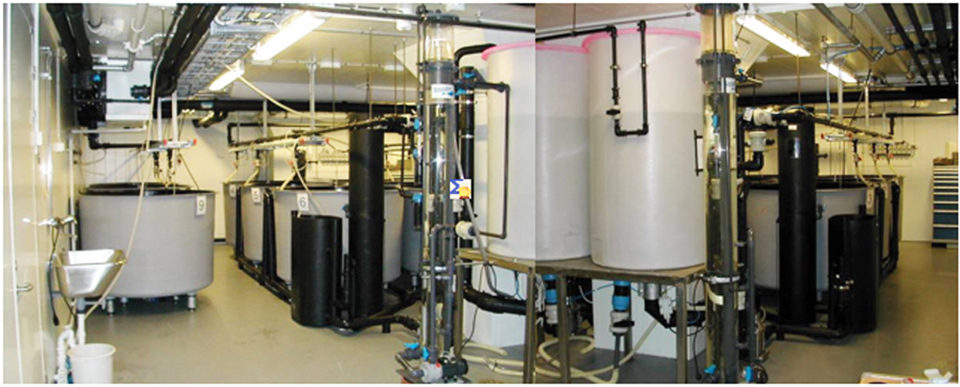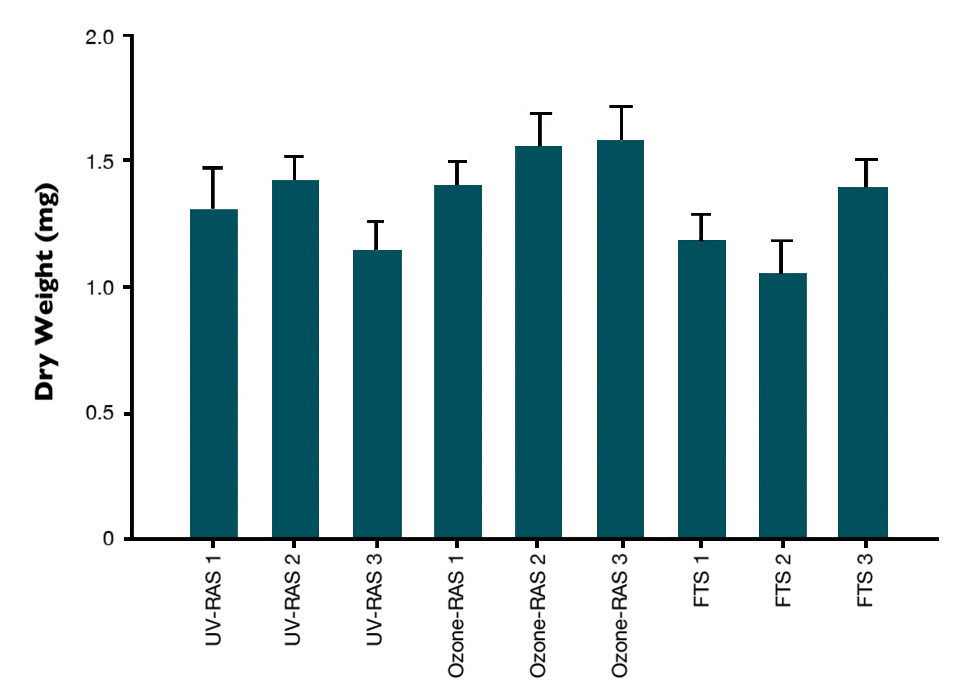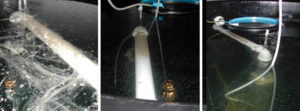Stabilization of the microbial community crucial for hatcheries

Newly hatched marine larvae lack a functional specific immune system and are vulnerable to general infections by opportunistic bacteria. In intensive hatchery cultivation, several procedures destabilize the microbial community and favor the proliferation of opportunistic and potentially harmful bacteria species.
Destabilizing factors include disinfection, high and fluctuating concentrations of organic matter, and high densities of fish and prey with associated microflora. Stabilization of the microbial community may counteract the proliferation of opportunistic bacteria.
Microbial maturation
Microbial maturation is an effective and documented strategy to control the bacterial composition of intake water that results in a more beneficial microbial environment for fish larvae. To mature intake water, microbial succession is allowed in a reservoir with a large surface area for bacterial growth.
The method is targeted at the relatively low organic matter load of intake water. The higher concentrations of organic matter in fish tanks and live feed production tanks provide new premises for selection and potential openings for opportunistic proliferation.
To create a stable and resistant microbial environment in which to rear fish, controlled selection should be carried out at an organic load similar to that of the rearing tanks.
Recirculation aquaculture systems (RAS) have properties that may contribute to improving and stabilizing the microbial environment in marine hatcheries. Conceptually, RAS allow a long water maturation time at high organic matter loads. A large surface area is available for bacterial growth in the biofilter. The heterotrophic biofilter consumes organic matter from feed loss and feces, and supplies the fish tanks with bacteria.
Marine hatcheries and grow-out systems are very different regarding biomass holding capacity, organic and particulate loading, water consumption and fish sensitivity. In hatcheries, biomass is low, and the larvae are sensitive to bacterial infections. Production of waste, oxygen consumption and organic loading are relatively low, and particles are small. In contrast, particle and waste product removal efficiency together with oxygen supply determine the success of production in growout systems. Microbial stability may be the main argument for using RAS in hatcheries.
Larval-rearing studies
RAS are widely used to stabilize chemical water quality, reduce water consumption and control waste emission. The authors recently conducted experiments to investigate whether recirculation can be used for microbial management by increased maturation time and selection for desirable bacteria at an organic matter load comparable to that in fish tanks. The work was supported by the Norwegian Research Council, Norwegian University of Science and Technology (NTNU), and Stiftelsen for Industriell Og Teknisk Forskning (SINTEF) Fisheries and Aquaculture.
In one experiment, the development of the microbial communities in a typical marine fish larval RAS with ozonation for Atlantic cod, Gadus morhua, was compared to a traditional flow-through system (FTS). The criteria used to define superior microbial water quality included a more stable microbial community composition over time, less variability among parallel fish tanks, higher diversity and a lower fraction of opportunists. Physiochemical water quality and fish performance were also evaluated.
In a second experiment, the physio-chemical and microbial qualities of culture water in RAS with ozonation (Ozone-RAS) or ultraviolet irradiation (UV-RAS) were compared to those of water in a traditional FTS. The Ozone-RAS was run with moderate ozonation to an oxidation reduction potential of 350 mV in a foam fractionator. This was not considered to represent disinfection.
Bacteria community development was different in the tanks of the two RAS, with the UV-RAS profile more similar to the microbial profile of the FTS. Fish performance was better (Fig. 1), and the microbial community development more stable and diverse in the Ozone-RAS. The physiochemical environment was similar in the two RAS. There was no reduction in bacterial activity measured following ozonation, confirming that the level of ozonation was too low to inactivate bacteria.

Due to turbid water from algae addition, the UV-RAS disinfection efficiency was low during the rotifer period. In the artemia period, however, there was a clear reduction in bacterial activity following ultraviolet irradiation. The varied microbial development observed may have been a result of different disinfection efficiencies.
Dry feed was introduced from day 30 post-hatch, and as a response, the fish tanks of the flow-through system were quickly overgrown by treadforming bacteria killing fish. Treads of bacteria were also found in both RAS, but they never proliferated in the same way as in the FTS.
In both experiments, the RAS developed and maintained significantly different and more diverse and stable microbial communities as compared to the FTS. This was reflected in similar or better performance of larvae in the RAS, despite an apparent inferior physiochemical water quality, as judged by traditional criteria. From these results, recirculation seems to be an easy and efficient way to stabilize the microbial environment in marine hatcheries.
Live feed production
In aquaculture of marine fish larvae, live feed is still necessary the first weeks after the yolk sacs of the fish have been absorbed. Live feed production is labor-intensive and can be unstable, which makes marine fish juvenile production time-consuming and costly. Even when rinsed before feeding, live feeds are commonly accompanied by high levels of opportunistic bacteria, including Vibrio species and hemolytic types.
It is possible to mitigate the microbial composition of live feed through, for example, algae. The bacterial flora of the live feed is directly transferred to first-feeding larvae, and a correlation has been found between bacterial counts on the live feed and larval mortality. Bacterial production in RAS rearing tanks has been shown to depend on the concentration of live feed. If the microbial composition of live feed culture can be stabilized and improved by using RAS, it seems this could also improve larval bacterial environment.
The development of new technology at SINTEF and NTNU has made it possible to produce rotifers in semi-continuous cultures in RAS for several months without the need to empty the production tank for cleaning.
As natural prey for coldwater marine fish, copepods have a beneficial nutrient composition with a relatively high content of highly unsaturated fatty acids for larval growth, survival and development. Experiments at SINTEF and NTNU showed that cultured Acartia tonsa increased the growth and survival of first-feeding Atlantic cod larvae.
Cultivation of copepods gives better control and biosecurity than what is available with wild catch. Ongoing experiments examining the microbial community development of culture water are being conducted to investigate the production of A. tonsa in RAS.
Membrane filtration

Small organic particles originating from algae, biofilters, live feed, feces and dead larvae are hard to remove and tend to accumulate in RAS hatcheries. Organic particles continuously dissolve to microbe substrate, so efficient removal may stabilize and reduce bacterial proliferation. In addition, the ammonia and carbon dioxide contribution resulting from bacterial degradation of waste particles can be limited by efficient solids removal.
The presence of live feed and other particles influences ultraviolet and ozone disinfection efficiency. Traditional solids-removal technology like microscreen filters combined with particle traps leave much of the dissolved, colloidal and fine fractions of the solids in the water. Microscreen filters are cost-effective, but not efficient in removing fine solids smaller than 60 µ. Membrane filtration may be a way to control the accumulation of the colloidal and fine fractions of the solids and reduce the amount of organic material and particles in marine RAS hatcheries.
Membrane bioreactors are commonly described as the combination of biological treatment using activated sludge and membranes for filtration to achieve an advanced level of organic, nutrient and suspended solids removal. Although not fully commercialized, some work has been conducted to test the potential of integrating membrane bioreactors in marine RAS. However, a number of commercial membrane bioreactor systems are successfully treating municipal and industrial wastewater.
As with all membrane processes, membrane permeability in the bioreactors is reduced due to the accumulation of materials on the surface of or within the membranes, which decreases the filtration flux. Membrane fouling is quite complicated and complex, but the main forms are solids deposition as a caked layer, pore clogging by colloidal particles, adsorption of soluble compounds and biofouling. It appears that suspended solids are only partially responsible for the increasing resistance during filtration. The dissolved and colloidal fractions are extensive contributors, as well.
Hybrid bioreactors
All research concerning membrane bioreactors in RAS water treatment systems to date has applied the active sludge process in combination with the membrane. Recent research has tested the application of an alternative wastewater treatment method combining a moving-bed biofilm reactor and a submerged membrane reactor, forming a hybrid biofilm membrane bioreactor. These hybrids have the potential to utilize the best characteristics of the biofilm process and membrane separation, resulting in a compact, efficient particle and nutrient removal system.
Perspectives
A stable nitrifying biofilm is harder to maintain in systems with cold and saline water. In addition, marine fish larval-rearing systems are operated with low, but exponentially increasing levels of substrate as the fish grow, which further complicates the operation.
Nitrification efficiency increases in RAS biofilters when the organic matter load of the water decreases. Separation in two designated biofilters may increase the efficiency of heterotrophic microbial maturation and chemoautotrophic microbial nitrification, respectively, by securing optimal selection pressure for each process. Membrane filtration upstream of the nitrifying filter could minimize organic loads and reduce competition with heterotrophic bacteria.
(Editor’s Note: This article was originally published in the July/August 2010 print edition of the Global Aquaculture Advocate.)
Now that you've finished reading the article ...
… we hope you’ll consider supporting our mission to document the evolution of the global aquaculture industry and share our vast network of contributors’ expansive knowledge every week.
By becoming a Global Seafood Alliance member, you’re ensuring that all of the pre-competitive work we do through member benefits, resources and events can continue. Individual membership costs just $50 a year. GSA individual and corporate members receive complimentary access to a series of GOAL virtual events beginning in April. Join now.
Not a GSA member? Join us.
Authors
-
Kari Attramadal
Norwegian University of Science and Technology
7491 Trondheim, Norway[111,110,46,117,110,116,110,46,111,105,98,64,108,97,100,97,109,97,114,116,116,97,46,105,114,97,107]
-
Astrid Buran
Norwegian University of Science and Technology
7491 Trondheim, Norway -
Olav Vadstein, Ph.D.
Norwegian University of Science and Technology
7491 Trondheim, Norway -
Yngvar Olsen, Ph.D.
Norwegian University of Science and Technology
7491 Trondheim, Norway -
Gunvor Øie, Ph.D.
Stiftelson SINTEF
Trondheim, Norway
Tagged With
Related Posts

Health & Welfare
Ammonia addition enhances microbial flocs in nursery phase for Pacific white shrimp
In a study, “pre-fertilization” in the nursery phase of a biofloc system for shrimp was tested. The objective was to accelerate the biofloc formation to minimize ammonia concentrations, avoiding high peaks during culture.

Intelligence
A brief look at genetically modified salmon
If approved by FDA, fast-growing genetically modified salmon will provide a safe and nutritious product similar to other farmed Atlantic salmon.

Health & Welfare
A holistic management approach to EMS
Early Mortality Syndrome has devastated farmed shrimp in Asia and Latin America. With better understanding of the pathogen and the development and improvement of novel strategies, shrimp farmers are now able to better manage the disease.

Responsibility
A look at various intensive shrimp farming systems in Asia
The impact of diseases led some Asian shrimp farming countries to develop biofloc and recirculation aquaculture system (RAS) production technologies. Treating incoming water for culture operations and wastewater treatment are biosecurity measures for disease prevention and control.


